11
Mounting the Camcorder
Our brain coordinates information from our eyes with our sense of balance and constructs an image of a stable external world that does not bounce when we walk or nod our head. A camcorder, on the other hand, can only partially compensate for shake (with optical image stabilization), and hand-held operation can easily create an unnatural experience of arbitrarily floating, bouncing, and tilting. A well-leveled tripod with a good “fluid head” allows the user to produce video with a balanced horizon, steady framing, potentially sharper pictures, gliding pans, and smooth tilts that are more like the way we perceive the world. A tripod or some other secure mount can be particularly important in situations where stability is critical, such as extreme close-ups, compositions requiring precise framing, and for long takes. Telephoto shooting is a perfect candidate for the solidity of a tripod because telephoto not only magnifies the image, it also proportionally magnifies any instability of the camera.
A poorly used tripod, on the other hand, can seem unnaturally rooted in one place. It can even limit the visual potential of your production if you simply use the tripod for convenience as opposed to clearly determining its position, height, framing, and repositioning based the form/content needs of the production. Physically placing the camera (and a tripod) within a scene positions the spectator. In terms of form and content, should the spectator be inside the circle of action, on its edge, or on the outside? These kinds of considerations are equally important for event videography such as for weddings, as well as for documentary or fiction. The G10/XA10 on a good lightweight tripod is unobtrusive and mobile enough that it can more easily be placed within the social space of the real or fictional event if necessary, and can easily be repositioned.
Obviously, a legal deposition on video is rather straightforward and simply requires a stationary eye-level tripod. But anything more complicated needs careful consideration. Framing a scene creates a relation with the world in front of the camera, and the choices of where to place a tripod and how high to stretch the legs have significant aesthetic consequences. Do you want the spectator to see the scene from an adult’s height, a child’s height, standing height, seated height, halfway in between, high angle, low angle, or from a meaningful selection and progression of heights? Should the tripod’s position, and consequently the position of the spectator, favor one character over another? Should the camera show us a seemingly objective view, a privileged view, or even a disadvantaged view? Should the framing set up a particular foreground/background relationship? Should the camera’s position and the limits of the frame imply a relationship to the world that extends beyond the frame?
Whether documentary or fiction, a scene needs to have moments of emphasis and de-emphasis as well as a relevant point of view—not simply one that occurs by default. Most scenes also need visual development. Sometimes these things can be achieved from a single tripod position—for example, in Citizen Kane when Kane signs over control of his assets to Thatcher following the stock-market crash. Visual development is achieved in this scene by gradually unveiling the characters. When Bernstein puts the contract down, Thatcher is revealed sitting at the table. Then Kane enters the frame and paces to the far depth of the room before he eventually joins the other two in the foreground and signs away financial control of his fortune. As a form/content relationship, an uninterrupted long take from a single relatively static position effectively captures Kane’s sense of defeat and his oedipal resentment of Thatcher. Most dramatic scenes will require a more dynamic position, multiple positions, or movement of the camera to provide progression and development. Documentary, music video, commercials, and event videography share a similar need for effective and meaningful positioning of the camera.
Selecting a Tripod
The four lightweight fluid-head tripods listed in Table 11.1 work well with the size and weight of the G10/XA10. The Manfrotto 190XB.700RC2, shown in Figure 11.1, is 20 percent heavier than the two lightweight Slik models and has a slightly slower quick-release because of its additional tightening screws. The 190XB.700RC2 has no ball leveler, but its central column provides 6½ inches greater height. The Slik DST1 (also shown in Figure 11.1) and DV Travel tripods are, for all practical purposes, identical except the latter model comes with a travel bag. Their advantages are their light weight, the ball leveler, a good quick-release plate, and a smooth fluid head. An extra pound lighter can make a big difference in the field, and the ball leveler in particular speeds up setup time. The principal shortcoming of these two models is that without a rising center column, the tripods do not quite come up to adult eye level. By foregoing a ball leveler, the Slik 504QF-II tripod system has a center column that reaches 60.6 inches. At a price of $130, it’s a bargain if you do not mind carrying the extra weight. In addition to its fluid pan and tilt, its head shifts 90° on a third axis to provide vertical orientation for still cameras.
Table 11.1 Tripods with Fluid Heads
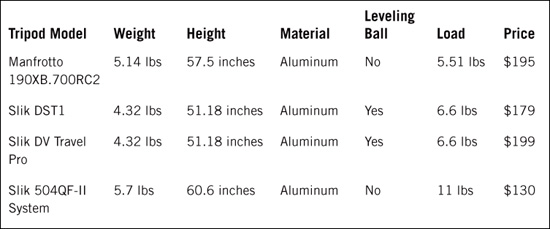
Figure 11.1 The Manfrotto 190XB.700RC2 tripod (on the left) and the Slik/Daiwa DST1 tripod (on the right).
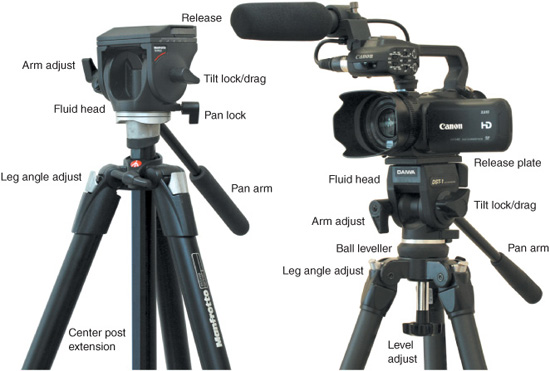
If you want a specific combination of height, weight, and load, or you’re particularly concerned with tension, inertia, or fluid movement, you might consider purchasing the legs and head separately. Manfrotto makes many different heads and tripods appropriate for the G10/XA10. Manfrotto products have very similar catalog numbers, which can be confusing; hopefully, Table 11.2 and Table 11.3 will help you differentiate the features of a selected series of models.
Table 11.2 Tripod Legs (Without Head)
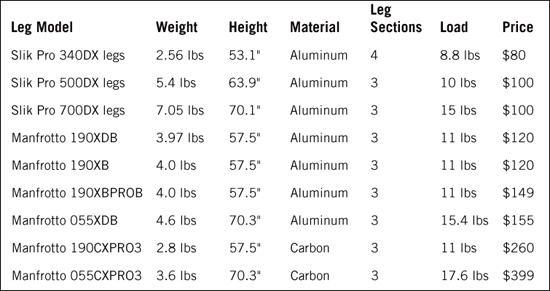
Slik legs are made of a strong aluminum-magnesium-titanium alloy. The four-segmented Slik Pro 340DX is the lowest priced and lightest set of tripod legs on the list. It also is the shortest and least sturdy when fully extended. The other two Slik Pro models are relatively inexpensive, yet sturdy and tall. The Manfrotto 190XDB set of legs is well matched to the G10/XA10 in weight, price, and size. It is a lighter, stripped-down version of the 190XB and 190XBPROB. The other two tripods in the 190 series listed in Table 11.2 have a low-angle adapter that provides a shooting height as low as 3.1 inches. The 190XBPROB also has a center post that tilts 90° to a horizontal position. This is useful for vertical portraits with a still camera or for creating an overhang to point a video or still camera straight down. The Manfrotto 055XDB is heavier than the 190 series, has a longer central post and extends much higher. Carbon fiber tripods are considerably lighter but more expensive. At 2.8 pounds, the carbon fiber 190CXPRO3 is one of the lightest among the models listed in Table 11.2. At roughly triple the price of the aluminum tripods, the Manfrotto 055CXPRO3 has a magnesium top plate and lightweight legs made of strong carbon fiber. Its center post extends to 68.9 inches and it weighs only 3.6 pounds.

The 700RC2 is Manfrotto’s lightest and smallest professional-quality fluid head. It can handle camcorders up to 5½ pounds, which is more than 2½ times the weight of the G10/XA10. Anything larger is overkill, but if you do not mind additional weight, you might also consider the other heads listed in Table 11.3. Each has its own quality of movement and a different design to its release mechanism, pan/tilt controls, and panning arm. The Slik 504QF-11 mounts on legs that provide a ¼-inch screw, whereas the others require a ![]() -inch mount found on most professional tripod legs. The Manfrotto 701HDV weighs 6.6 ounces more than the 700RC2. It is an excellent head if you also intend to use camcorders and still cameras with heavy lenses. The 701HDV and the 701RC2 (shown in Figure 11.2) have an additional centering adjustment and lock so that a camera’s center of gravity can be shifted forward or backward on the head.
-inch mount found on most professional tripod legs. The Manfrotto 701HDV weighs 6.6 ounces more than the 700RC2. It is an excellent head if you also intend to use camcorders and still cameras with heavy lenses. The 701HDV and the 701RC2 (shown in Figure 11.2) have an additional centering adjustment and lock so that a camera’s center of gravity can be shifted forward or backward on the head.
Figure 11.2 Manfrotto 701RC2 fluid head.
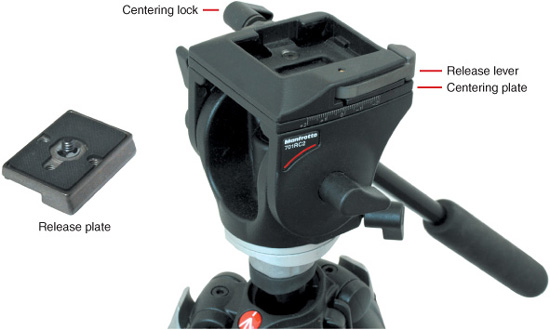
The 701HDV and some of the other heads have a more straightforward quick-release mechanism than the 700RC2. To make certain the base plate is secure, the Manfrotto 700RC2 and the Davis and Sanford V12 have a secondary safety catch and an additional video pin that prevents movement of the plate, which add an extra couple of seconds to mounting or removing the camera. Some videographers do not like spending the extra seconds, while others consider it a fair trade-off for a more tightly secured camcorder.
Monopods
Sometimes, tripods are too big, too heavy, too cumbersome, or simply inappropriate for certain shooting situations. In contrast, monopods are lightweight, sturdy, and inexpensive, and require minimal or no setup time compared to a tripod. They provide a flexibility somewhere between the freedom of hand-held and the stability of a tripod, and can enable additional possibilities for shooting, positioning, and stabilizing the camcorder. (See Figure 11.3.)
Figure 11.3 Manfrotto 560B and 676B monopods.
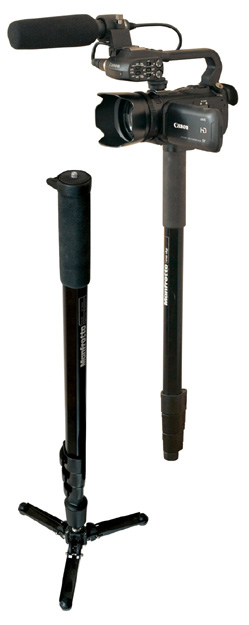
In terms of weight, size, leverage, and balance, the best-matched monopod to the G10/XA10 is the Manfrotto 776YB, a.k.a. 676B or 3006B. (As Manfrotto makes slight revisions—for example, in the shape of the latches—the company changes the model number. Manfrotto continually refines its products, so the model number may change again by the time you read this book. Look for a monopod with similar characteristics.) The 776YB has nearly the same general specifications as the 676B Digi monopod ($55 to $65), which is still available from some sources, and the 3006B, which was on the market several years ago.
The 776YB (12 ounces) and the 676B (14 ounces) can handle a load up to 10 pounds. Their leg sections are a rounded, triple-sided shape that bolsters their rigidity and allows them to extend or retract quickly without binding, The triple-faceted shape makes the column easier to hold without slipping or turning in your hand, as can happen with round monopods. Their four-section column extends to a height of 60.6 inches and collapses to a compact 18.9 inches. Manfrotto’s ultra compact MMC3-02 weighs 10.2 ounces. It has a gray oval column with five sections that collapse to 15.35 inches. When extended to its full height of 57.28 inches, it is a bit flimsy compared to the other models, and it supports only 3.31 pounds—which is still enough for the G10/XA10. It sells for only $25. For an even lighter mount, Sunpak makes the PRO 424MX carbon fiber monopod for a price of $50 to $75. It weighs 8.8 ounces, can handle a load of 15 pounds, reaches a height of 56 inches, and retracts to 19.5 inches. My personal preference for the G10/XA10 is still the Manfrotto 776YB or 676B.
Some users accessorize the monopod with a base on the top that holds a quick-release camera plate. This could be useful if you anticipate quickly swapping the camcorder between the monopod and a tripod that accepts the same plate. However, if you want the lightest possible rig, simply attach the monopod directly to the camcorder. It takes less than three rotations to attach or unscrew the monopod. Still photographers often add a tilt or ball head to the monopod to shoot vertical compositions, but this is not essential for the G10/XA10 in video mode.
The usefulness of a monopod extends beyond resting it on the ground during long takes or stabilizing telephoto shots. For additional support while mobile, some video-graphers will park the tip of the monopod leg in a belt pouch or rest it waist-high on a case for small accessories held by a shoulder strap. Even when fully hand-held without the tip resting on anything, an extended or partially extended monopod adds balance while you shoot, like a tightrope walker’s pole.
Lifted above the operator’s head, a monopod can become an instant hand-held crane, camera boom, or jib. It can shoot over the heads of a crowd or provide a high-angle shot. It can also be used to shoot just inches off the ground by holding the monopod upside down and uprighting the image in postproduction.
The Manfrotto 560B1 ($155) and 560B are current and previous models of a monopod with three retractable feet, which provide a steadier foundation. The big innovation with this monopod is a fluid-damped ball head built into the three-footed base to create smoother panning and more stability when shooting on a tilted angle. The 560B (pictured on the left in Figure 11.3) is particularly useful in tight places over extended periods of time where a tripod may not be allowed, like sports and public events. Its four sections extend to a length of 65.5 inches and collapse to 26 inches. It weighs 1.54 pounds, approximately twice the weight of the 776B.
Vehicle Mounts
One of the advantages of a palm-sized camcorder like the G10/XA10 is the ability to place it almost anywhere—for example, in a car. Cars are an integral part of contemporary life. What would feature films be like without car scenes, or modern documentaries without the ability to film conversations in cars? For many of us, a significant portion of our daily life is spent in a car: traveling, commuting, doing chores, or at leisure. As a container for one or more human beings, a car creates its own hermetic world—a pocket of private space within the larger world that passes by the windows. The enclosed space of a vehicle can even intensify relationships as people share cramped quarters for the duration of a ride.
Iranian director Abbas Kiarostami is a master of writing and directing scenes taking place in cars. Most of his 95-minute feature film, A Taste of Cherry, is an extended car ride as a man searches the outskirts of Tehran to hire someone to bury him after he commits suicide. A Taste of Cherry won the Cannes Film Festival Palme d’Or in 1997.
Kiarostami’s film Ten is composed entirely of conversations and interactions during 10 car trips over the period of a day or two as a divorced Iranian woman drives her son, her sister, a praying woman, a prostitute, and others within the city of Tehran. We never leave the inside of a car during the 94-minute production. Ten is listed in Empire Magazine’s “100 Best Films of World Cinema” and named by Cahiers du Cinema as one of the “10 Best Pictures of the 2000s.” Yet Ten was produced with the simplest of technology: two palm-sized camcorders mounted on each corner of the dashboard or windshield—one framing the driver and the other framing the passenger. Ten was shot in PAL DV, which has a resolution of 414,720 pixels. In comparison, the G10/XA10 has 2,073,600 pixels—five times the picture quality.
Although I have been describing feature fiction films, the concept of mounting a camcorder in a car equally applies to documentary, music video, commercials, travelogues, event videography, and personal media. You may already have the G10 or XA10; now all you need is a car mount.
The Panavise 809 Camera Window Mount ($26), shown in Figure 11.4, holds up to 3 pounds on a smooth, flat, non-porous surface like a car window. It has just barely enough strength to secure the G10/XA10, which weighs approximately 2 pounds with its battery installed. The Panavise consists of a ball joint that rotates 360° and tilts −90/+90° with a camera screw and locking collar mounted on a strong 3¼-inch suction cup. For a more secure professional mount, the Gripper 115 ($79) made by Film Tools has a 4¼-inch suction grip and is rated for up to 50 pounds. Film Tools makes an even heavier Gripper, model 116XL ($110–$140), which has a 6-inch suction grip, metal support rods, and is rated for up to 70 pounds. The 4¼-inch vacuum grip should be more than adequate for inside an automobile.
Figure 11.4 The lightweight Panavise 809 window mount for cameras.
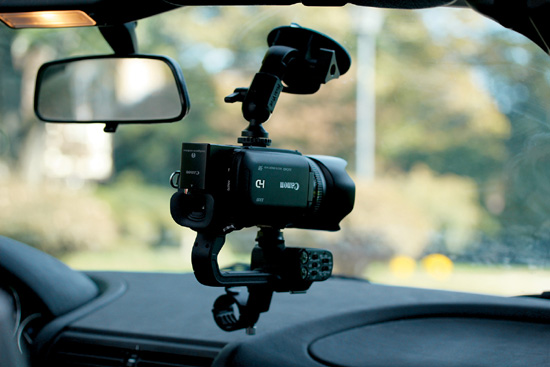
The mounting surface must be clean. Also, it is useful to dampen both the surface and the suction cup with water spray. Then, simply press the cup against the surface, press its pump mechanism, and pull up the grip’s locking lever to clamp the camera support mechanism tightly against the cup. The camcorder can be pointed at the driver or passenger, or can be turned to shoot through the window on which it has been mounted. If you intend to shoot through the front window, the camcorder will need to be mounted upside down because of the slant of the typical windshield. This is no problem. The image can be digitally turned upright and re-rendered in most video-editing programs. Alternatively, you can correct it to be upright as you record it by using Scan Reverse record mode. Reverse scanning allows you to invert the image horizontally, vertically, or both. Shooting upside down needs both horizontal and vertical correction to create an upright image. (Choose FUNC > Film Clip icon > Scan Reverse Rec > Both.)
A vacuum grip will also mount externally on a flat area of the metal car body, if you are willing to take the risk. You can minimize this risk by also tethering the camera and its vacuum grip to some additional point on the car or to a second heavy-duty vacuum device like the FastCap Handle on Demand ($11), which is a plastic handle mounted on two large suction cups similar to a professional vacuum hand grip. Some cars’ suspensions and some road surfaces may produce excessive vibration, particularly with the lightweight Panavise 809. You will need to experiment with the vacuum grip to determine when it will be more effective than simply hand-holding the camcorder inside the vehicle.
A vacuum grip can mount on any non-porous, flat surface that will sustain a vacuum, such as metal, glass, plastic, or Formica. It lends itself to many types of situations, not just vehicles—for example, on a kitchen countertop, a dressing-room mirror, or an upper pane of a house window to get a high-angle shot that would be impossible on a tripod. As with the exterior of a car, you might want to tether the rig to a stationary object or an auxiliary vacuum grip when mounting the G10/XA10 on vertical surfaces like a mirror or house window.
Another kind of car mount simply uses the upper edge of a side window as a vantage point, as shown in Figure 11.5. The Bushnel car-window mount ($27), the Manfrotto 243 car-window pod ($26), and the Giottos professional car-window mount ($54) provide a way to shoot external views with the camcorder from the comfort and convenience of a stationary car instead of setting up a tripod. Unlike the Film Tools and Panavise vacuum grips, these mounts are not intended to be used in a moving vehicle. They fit over the upper lip of a partially lowered car window. You secure them in place by gently tightening a padded clamp against the window glass.
Figure 11.5 The Bushnel car-window mount.

The pan/tilt head on the Bushnel car-window mount is simply for positioning, not for fluid camera movements. The Bushnel mount itself is very lightweight, so users must be careful that it does not slip because adding the G10/XA10 creates a high center of gravity. The Giottos mount has an integrated pan/tilt head like the Bushnel, but is heavier duty. The Manfrotto 243 is quite sturdy, but is simply a clamp base for which you must separately purchase a pan/tilt head. The Manfrotto terminates in a ![]() -inch screw, which allows you to attach a fully functioning fluid video head like the 700RC2 ($76). The 700RC2 can produce smooth pans and tilts, provided the car window is not loose in its tracks.
-inch screw, which allows you to attach a fully functioning fluid video head like the 700RC2 ($76). The 700RC2 can produce smooth pans and tilts, provided the car window is not loose in its tracks.
